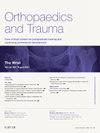腕关节的临床检查
Q4 Medicine
引用次数: 0
摘要
精心排练和熟练的手腕临床检查是FRCS检查成功结果的关键,也是确定患者症状的准确诊断的关键。在要求适当的调查之前,从集中的病史和彻底的检查中精确定位病理是至关重要的。虽然由于多个解剖结构接近,很难定位病变,但系统的检查将避免遗漏的病理。在记录病史的同时,将腕关节症状划分为桡侧、中央侧或尺侧是很有用的,因为这将指导检查者相应地集中检查。本文将详细介绍常规手腕检查,随后重点介绍常见亚急性和选择性疾病的具体检查结果。与任何肌肉骨骼检查一样,准确诊断的关键是基础解剖学知识及其与手腕和手的功能的相关性。虽然本文的范围限制了对解剖学的讨论,但强烈建议您精通解剖学。本文章由计算机程序翻译,如有差异,请以英文原文为准。
Clinical examination of the wrist
A well-rehearsed and slick clinical examination of the wrist is key to a successful outcome in the FRCS exam as well as ascertaining accurate diagnosis of a patient’s symptoms. Precise localization of the pathology from a focused history and thorough examination is crucial prior to requesting appropriate investigations. Although localization of offending pathology can be difficult due to multiple anatomical structures in close proximity, a systematic examination will avoid missed pathology. It is useful to compartmentalize wrist symptoms as being radial sided, central or ulnar sided whilst taking the history as this will direct the examiner to focus their examination accordingly. This article will detail a routine of wrist examination with subsequent focus on specific tests and findings present in common subacute and elective conditions. As with any musculoskeletal examination, the key to accurate diagnosis is working knowledge of underlying anatomy and its relevance to functions of the wrist and hand. Whilst the scope of this article limits discussion of anatomy, it is highly recommended to be well versed with this.
求助全文
通过发布文献求助,成功后即可免费获取论文全文。
去求助
来源期刊

Orthopaedics and Trauma
Medicine-Orthopedics and Sports Medicine
CiteScore
1.00
自引率
0.00%
发文量
57
期刊介绍:
Orthopaedics and Trauma presents a unique collection of International review articles summarizing the current state of knowledge and research in orthopaedics. Each issue focuses on a specific topic, discussed in depth in a mini-symposium; other articles cover the areas of basic science, medicine, children/adults, trauma, imaging and historical review. There is also an annotation, self-assessment questions and a second opinion section. In this way the entire postgraduate syllabus will be covered in a 4-year cycle.
 求助内容:
求助内容: 应助结果提醒方式:
应助结果提醒方式:


